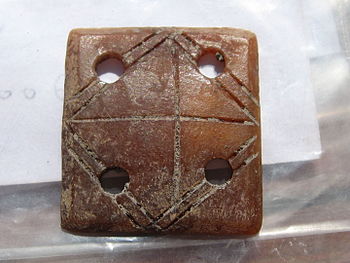One of the big problems that archaeologists deal with is finding things that they simply can’t identify. For a number of years I was on an email list, conceived of and managed by Dr Dan Carlson, an Archaeologist working in Fröjel harbor in Sweden. Occasionally they would find something that they had questions about, and they would send a description and picture of the item out to the “hive mind” to ask for help. and often someone would have a clue. I remember one time in particular. I emailed this message:
“To me it looks like a tiny beater that could be used in tablet weaving or other narrow band weaving. I use something similar, made of wood, place it in the weaving shed and pull it gently towards the newly woven cloth to push the newly placed weft in place. I will be watching to see what other people think it is!”
The response from the archaeologist?
“You are obviously right! Most people have the same suggestions, and thinking of the pieces of thin plates of bone for tablet weaving at the sight, shows clearly that the technique was used at the site.”
The basic problem is that it is almost impossible for a researcher, or even a team of researchers, to have a complete knowledge of all of the equipment that was used in every art and craft, in any given culture. And now take even identifiable objects, and break them into pieces, and see if you can figure out what they used to be. And then take those pieces, and allow time and weather to corrode them and wear them away, and what do you have? Archaeology is often like a giant jigsaw puzzle where the box with the picture is missing, and the cat has eaten some pieces, and chewed up other ones.
And this problem does not become any less severe when we work during later time frames with more complex machinery. In about 1985 I was working in the Archaeology Lab at the University of Houston, as a grad student. One project involved a house that was burned because the inhabitants had died of Yellow Fever. (In the 1800’s people did not know that Yellow Fever was a mosquito borne disease, they thought it spread by contact, like Small Pox.) The head of the department suggested that I look at the finds because I “had a knack” for identifying odd pieces of metal. (I have always loved machinery and used to regularly take things apart and put them back together when I was a child.) They thought they were dealing with the daughter’s room, but could not be sure, and one of the other grad students poured out a bag of very rusty pieces of iron. And I knew what she had.
It was broken into about a dozen pieces, and had a different style frame than the one in the picture, but what she had were the pieces of a music box. The spring, the frame to hold the roller, the holder for the comb, and the comb to “plink” on the roller, were clear as day… to me. She had never seen the inside of a music box before, and had never even thought about how they worked.
So when you are busy looking through a museum’s digital collection, take a good look. Watch for mistakes (we all make them!), and if you think that you know what something is, do not hesitate to contact the museum. You could help them solve a mystery, or simply point out inadequate information on an old entry. And some, like the MET, may even send you a thank you email!


